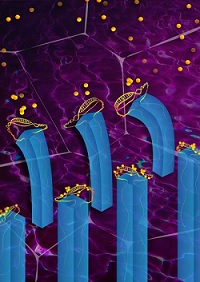 |
| Hydrogel-aptamer capture and release, with aptamers extending to be exposed to binding molecules--Courtesy of Arizona State University |
Taking a cue from natural systems of biological transport, material scientists at Arizona State University have designed a "biomimetic analogue" capable of self-regulating and affecting biological systems. With this new technique for handling molecules, the researchers hope to bring about new drug delivery systems, as well as many other applications.
The team developed a hydrogel that mimics properties of living tissue, according to a release, by reacting to its environment. This can be tuned to temperature, pH or metabolite concentration to make the hydrogel expand or contract to release molecules embedded in the gel. In this study, the hydrogel detected the human enzyme thrombin, and in a low-pH environment, the aptamers (molecules sensitive to a chemical target) that make up the hydrogel denature, releasing the thrombin.
This process mimics what is called in nature a feedback loop, using a signal to indicate when a molecule or material is needed to maintain normal biological functions.
"Biological systems use feedback as a crucial component to provide efficient performance," lead author Ximin He said in a statement. "Yet, the use of feedback has not been exploited to a sufficient extent in the design of new material systems... We must learn how to engineer responsiveness to environmental changes and the ability to perform important functions into the framework of new materials. In this research, the components are integrated to enable adaptive functionality."
The implications for drug delivery are vast, allowing the possibility for smart materials to carry drugs and release them according to environmental cues.
- here's the release